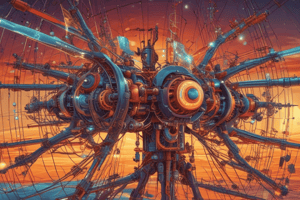Podcast
Questions and Answers
What is the scientific definition of work?
What is the scientific definition of work?
Work is done when a force makes something move.
What is the SI unit of work?
What is the SI unit of work?
The SI unit of work is the joule (J).
How is work calculated?
How is work calculated?
Work is calculated using the equation: Work Done = Force × Distance Moved.
What does energy represent in scientific terms?
What does energy represent in scientific terms?
What type of energy is associated with a moving object?
What type of energy is associated with a moving object?
What energy store is involved when an object is lifted against gravity?
What energy store is involved when an object is lifted against gravity?
What type of energy is stored in materials due to their atomic bonds?
What type of energy is stored in materials due to their atomic bonds?
What energy store is created by electric charges that attract but are held apart?
What energy store is created by electric charges that attract but are held apart?
What happens to the energy of a brick as it falls to the ground?
What happens to the energy of a brick as it falls to the ground?
What are the four pathways through which energy can be transferred?
What are the four pathways through which energy can be transferred?
Explain how thermal energy is related to internal energy in materials.
Explain how thermal energy is related to internal energy in materials.
What is the equation that relates work done and energy transferred?
What is the equation that relates work done and energy transferred?
How can potential energy be defined in the context of magnetic energy?
How can potential energy be defined in the context of magnetic energy?
What is the importance of the variable 'g' in the weight equation?
What is the importance of the variable 'g' in the weight equation?
Describe the relationship between force, mass, and acceleration using an equation.
Describe the relationship between force, mass, and acceleration using an equation.
In which units is work measured, and how does it relate to energy?
In which units is work measured, and how does it relate to energy?
How is work done calculated in an engine?
How is work done calculated in an engine?
Define efficiency in the context of an engine.
Define efficiency in the context of an engine.
What does it mean if an engine has an efficiency of 25%?
What does it mean if an engine has an efficiency of 25%?
Explain the relationship between the total energy output and total energy input in a system.
Explain the relationship between the total energy output and total energy input in a system.
How do you calculate power, and what is its SI unit?
How do you calculate power, and what is its SI unit?
What historical significance does the horsepower (hp) unit have?
What historical significance does the horsepower (hp) unit have?
Provide an example of energy transfer in a power plant.
Provide an example of energy transfer in a power plant.
Describe the energy transformation when a rubber band is released.
Describe the energy transformation when a rubber band is released.
Flashcards
Nuclear Energy
Nuclear Energy
Energy stored within the nucleus of an atom and released when the nucleus splits or its particles rearrange.
Potential Energy
Potential Energy
Energy stored in an object due to its position or configuration.
Thermal Energy
Thermal Energy
Energy associated with the random motion of particles within a substance.
Work Done
Work Done
Signup and view all the flashcards
Energy Transferred
Energy Transferred
Signup and view all the flashcards
Mechanical Energy Transfer
Mechanical Energy Transfer
Signup and view all the flashcards
Electrical Energy Transfer
Electrical Energy Transfer
Signup and view all the flashcards
Heat Transfer
Heat Transfer
Signup and view all the flashcards
Efficiency
Efficiency
Signup and view all the flashcards
Power
Power
Signup and view all the flashcards
Horsepower (hp)
Horsepower (hp)
Signup and view all the flashcards
Law of Conservation of Energy
Law of Conservation of Energy
Signup and view all the flashcards
Kinetic Energy
Kinetic Energy
Signup and view all the flashcards
Work (in physics)
Work (in physics)
Signup and view all the flashcards
Joule (J)
Joule (J)
Signup and view all the flashcards
Energy
Energy
Signup and view all the flashcards
Gravitational Potential Energy
Gravitational Potential Energy
Signup and view all the flashcards
Elastic (Strain) Energy
Elastic (Strain) Energy
Signup and view all the flashcards
Chemical Energy
Chemical Energy
Signup and view all the flashcards
Electrostatic Energy
Electrostatic Energy
Signup and view all the flashcards
Study Notes
Work
- Work is done when a force moves an object.
- The greater the force and the distance moved, the more work is done.
- The SI unit of work is the joule (J).
- 1 joule of work is done when a force of 1 newton (N) moves an object 1 metre in the direction of the force.
- Work is calculated using the equation: work done = force × distance moved in the direction of the force (W = Fd).
Energy
- Energy is measured in joules (J).
- Energy is stored in different ways.
- Moving objects store kinetic energy.
- Objects lifted upwards store gravitational potential energy.
- Stretched objects (like rubber bands or springs) store elastic potential energy.
- Chemical reactions store chemical energy.
- Stored electric charges store electrostatic energy.
- The particles inside atoms store nuclear energy.
- Moving particles in materials store thermal energy.
- Magnets store magnetic energy.
- Energy can be transferred from one store to another.
Energy Stores
- Kinetic energy is stored by moving objects.
- Gravitational potential energy is stored by objects that are lifted against gravity.
- Elastic potential energy is stored by stretching objects.
- Chemical energy is stored in fuels, foods and batteries.
- Electrostatic energy is stored in the electric charges that exist in objects.
- Nuclear energy is stored in the nucleus of an atom.
- Thermal energy is stored in the moving particles within materials.
- Magnetic energy is stored by magnetic objects
Energy Pathways
- Energy can be transferred mechanically (by a force moving something).
- It can be transferred electrically (by an electric current).
- It can be transferred through heating (because of a temperature difference).
- It can be transferred by radiation (such as light waves and sound waves).
Conservation of Energy
- Energy cannot be created or destroyed, only transferred from one store to another.
- The total quantity of energy stays the same.
Work and Energy Transferred
- Work done is equal to the energy transferred.
- When work is done, energy is transferred from one store to another.
- For an object of mass m at a vertical height h above the ground: gravitational potential energy = mgh.
- For an object of mass m and speed v: kinetic energy = ½mv².
Efficiency
- Efficiency is the percentage of energy that is usefully transferred.
- Efficiency = (useful work done ÷ total energy input) ×100%
Power
- Power is the rate at which work is done (or energy is transferred).
- The SI unit of power is the watt (W).
- Power = (work done ÷ time taken) or power = (energy transferred ÷ time taken).
Studying That Suits You
Use AI to generate personalized quizzes and flashcards to suit your learning preferences.
Related Documents
Description
Test your understanding of work and energy in physics. This quiz covers key concepts such as the definition of work, its SI unit, and different forms of energy storage. Brush up on your knowledge of kinetic and potential energy concepts to ace this quiz!




